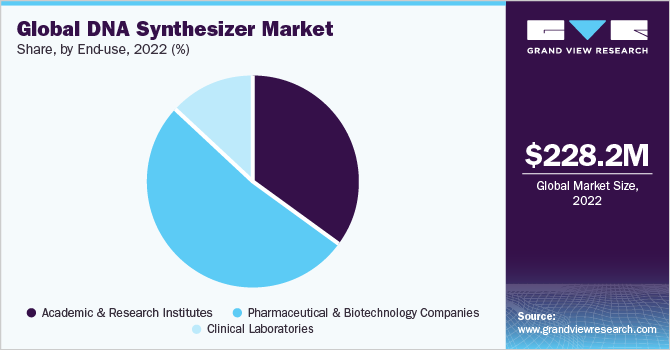The global DNA synthesizer market size was valued at USD 228.2 million in 2022 and is expected to reach USD 664.2 million by 2030, growing at a compound annual growth rate (CAGR) of 14.42% from 2023 to 2030. The growing demand for efficient DNA synthesizers from life science laboratories, pharmaceutical, and biotechnology companies is a major factor driving the market.
In addition, advancements in genomics and life sciences, along with the rising significance of DNA synthesizers in synthetic and molecular biology, are further contributing to market expansion.
The outbreak of COVID-19 had both positive and negative impacts on the industry. On one hand, the pandemic increased demand for advanced synthesizers and related technologies as researchers developed diagnostics and treatments for COVID-19. On the other hand, disruptions in research activities, raw material supply delays, and manufacturing restrictions negatively affected the market. However, since mid-2021, the market has experienced significant recovery and is projected to grow steadily due to increasing adoption of nucleic acid synthesis platforms across diverse end users.

The demand for benchtop DNA synthesizers is also rising due to their ability to enhance research speed and efficiency in both academic and industrial laboratories. This trend is encouraging manufacturers to develop reliable benchtop systems. For example, in June 2021, DNA Script launched the SYNTAX system, the first benchtop nucleic acid printer powered by EDS technology, aimed at strengthening genomics and molecular biology workflows. Such innovations are expected to further drive market growth.
Additionally, efforts to reduce the cost of DNA oligonucleotide synthesis and commercialize scalable synthesizers have intensified in recent years. The adoption of microfluidic/microarray-based synthesis methods and improvements in synthetic DNA quality have contributed significantly to this progress. Alongside market competition and ongoing advancements in synthesis technologies, these factors are expected to enhance the availability of affordable DNA synthesizers in the coming years.
Key Market Highlights:
- North America accounted for the largest market share of 39.22% in 2022.
- By type, the benchtop DNA synthesizers segment dominated the market with a share of 72.72% in 2022.
- By application, the drug discovery and development segment led the market with a revenue share of 48.11% in 2022.
- By end-use, the pharmaceutical and biotechnology companies segment held the highest revenue share of 52.37% in 2022.
Download a free sample PDF of the DNA Synthesizer Market Intelligence Study from Grand View Research.
Market Performance:
- 2022 Market Size: USD 228.2 Million
- 2030 Projected Market Size: USD 664.2 Million
- CAGR (2023-2030): 14.42%
- North America: Largest Market in 2022
- Asia Pacific: Fastest growing market
Prominent Companies & Market Dynamics:
The DNA synthesizer market is highly competitive, with several leading companies striving to expand their market presence. Key players are pursuing strategies such as mergers, acquisitions, partnerships, and product launches to strengthen their positions. For instance, in March 2023, Elegen introduced its ENFINIA DNA platform for rapid DNA synthesis, paving the way for the development of advanced synthesizers leveraging this technology in the near future.
Key Companies:
- Danaher
- Twist Bioscience
- Kilobaser
- LGC Limited
- CSBio
- K&A Labs GmbH
- DNA Script
- OligoMaker ApS
- PolyGen GmbH
- Biolytic Lab Performance Inc.
Explore Horizon Databook – the world’s most comprehensive market intelligence platform by Grand View Research.
Conclusion
The DNA synthesizer market is set for strong growth, driven by rising demand from pharmaceutical and biotechnology companies, rapid advancements in genomics, and the expanding role of synthetic biology. While the COVID-19 pandemic initially created challenges, it also highlighted the critical importance of advanced DNA synthesis platforms in accelerating research and diagnostics. Increasing adoption of benchtop systems, ongoing efforts to reduce synthesis costs, and innovations in scalable technologies are further shaping the market’s future. With continuous investments, product launches, and strategic collaborations among key players, the market is expected to witness sustained expansion, offering new opportunities for both research institutions and commercial enterprises in the years ahead.

No comments:
Post a Comment